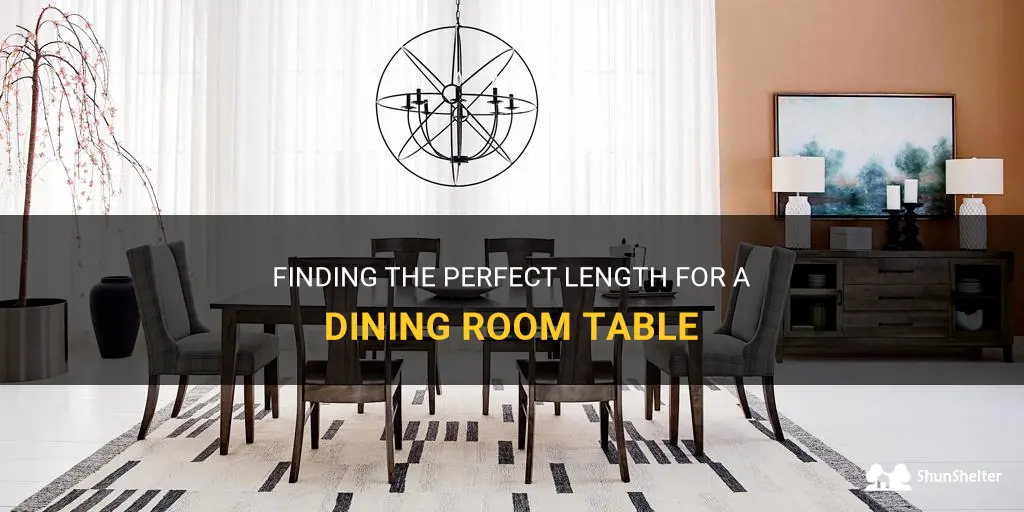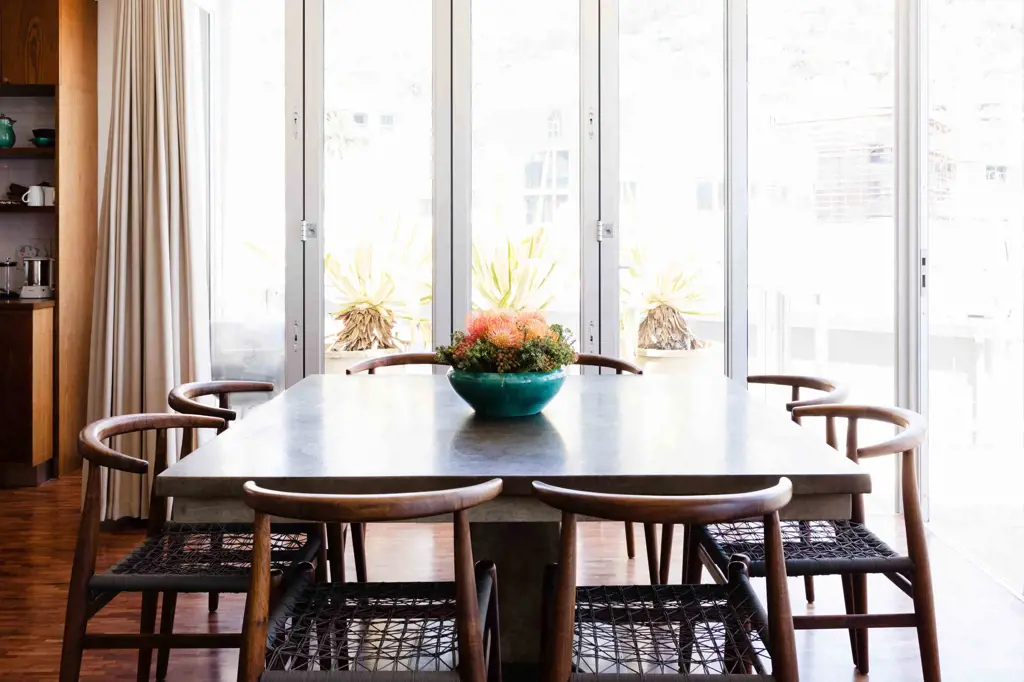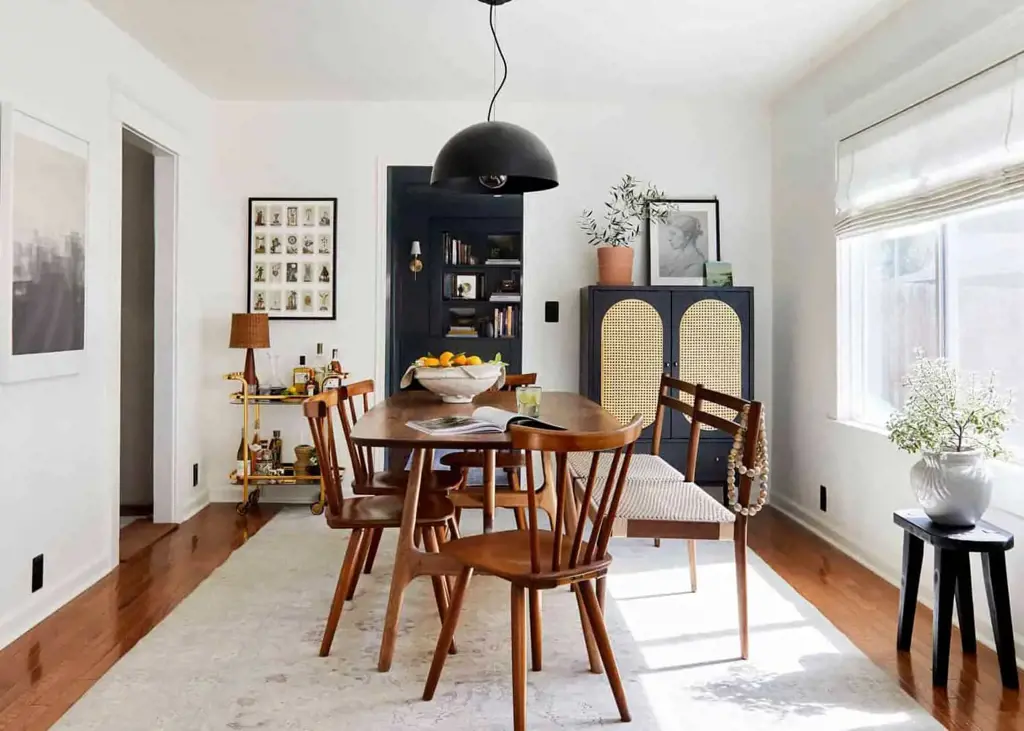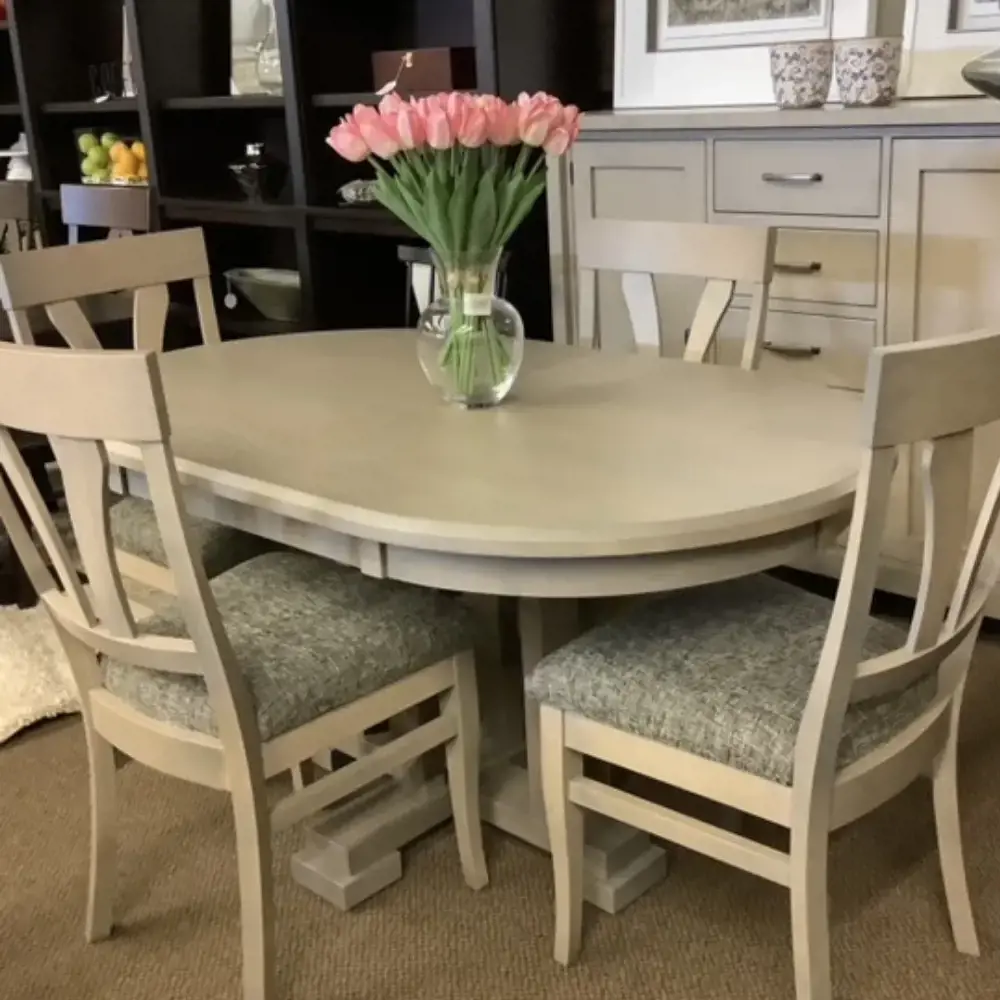
When it comes to choosing the perfect dining room table, many factors come into play, but one of the most important considerations is the table's length. The length of a dining room table can greatly impact the functionality and overall aesthetic of the space. Whether you have a small, intimate gathering or a large, lively dinner party, finding the right table length is crucial in creating the perfect dining experience. So, how long should a dining room table be? Let's delve into this topic and explore the various factors that come into play when determining the ideal length for your dining room table.
| Characteristics | Values |
|---|---|
| Number of seats | 2-4 |
| Table width | 36-48" |
| Table length | 72-96" |
| Table height | 28-30" |
| Room size | 9x9 ft+ |
What You'll Learn
- What is the optimal length for a dining room table?
- How does the size of a dining room table affect seating capacity?
- Are there any general guidelines for determining the appropriate length of a dining room table based on room size?
- How can the shape and style of a dining room table impact its ideal length?
- Are there any factors specific to the needs and preferences of the individuals using the dining room table that should be considered when determining its length?

What is the optimal length for a dining room table?

When it comes to selecting a dining room table, length is an important factor to consider. The optimal length of a dining room table depends on various factors such as the size of the room, the number of people you expect to accommodate, and the intended use of the table. In this article, we will explore the factors to consider and provide some guidance on determining the optimal length for your dining room table.
One of the key considerations when determining the optimal table length is the size of your dining room. You want to ensure that there is enough space for people to move around the table comfortably without feeling cramped. As a general rule of thumb, you should aim to have a clearance space of at least 36 inches (or 91 cm) between the edge of the table and the surrounding walls or furniture. This will provide ample space for chairs to be pushed back and for people to move in and out of their seats.
Another important factor to consider is the number of people you expect to accommodate at the table. A good starting point is to allocate around 24 inches (or 61 cm) of table width per person. This takes into account the space needed for plates, cutlery, and elbow room. For example, a table that is 72 inches (or 183 cm) long would comfortably seat six people, with each person having 24 inches (or 61 cm) of space.
However, it is worth noting that this calculation assumes rectangular tables. If you are considering a round or oval-shaped table, you may need to adjust the calculations slightly. For a round table, you can generally fit one person per foot of diameter. So, a 60-inch (or 152 cm) round table would comfortably seat six people.
In addition to size and seating capacity, you should also consider the intended use of the table. If you frequently host large gatherings or dinner parties, you may want to opt for a longer table to accommodate more people. On the other hand, if you primarily use the table for everyday meals with your family, a smaller table may be more practical.
Ultimately, the optimal length for a dining room table will vary depending on your specific needs and preferences. It is important to measure your dining room and consider the factors mentioned above before making a decision. Additionally, it may be helpful to create a mock-up of the table using newspaper or tape on the floor to visualize how it will fit in the space.
To summarize, when determining the optimal length for a dining room table, consider the size of the room, the number of people you expect to accommodate, and the intended use of the table. Aim for a clearance space of at least 36 inches (or 91 cm) around the table and allocate around 24 inches (or 61 cm) of table width per person. Keep in mind that these measurements are general guidelines, and it is important to tailor them to your specific needs. By taking these factors into account, you can ensure that your dining room table is the perfect fit for your space and lifestyle.
Choosing the Perfect Chandelier for Your Dining Room: A Guide to Creating a High-End Ambiance
You may want to see also

How does the size of a dining room table affect seating capacity?

When it comes to choosing a dining room table, one important factor to consider is the size and how it affects the seating capacity. The size of a dining room table can significantly impact how many people can comfortably be seated around it. In this article, we will discuss how the size of a dining room table affects seating capacity.
Scientifically, the size of a dining room table determines how many chairs can be placed around it. There are standard measurements that can be used as a reference. A common rule of thumb is to allow around 24 inches of space per person for comfortable seating. This means that for a rectangular table, you can easily calculate the maximum seating capacity by dividing the table's length by 2. For example, a 6-foot long table can accommodate around 6 people comfortably, while an 8-foot long table can seat around 8 people.
Additionally, the shape of the table also plays a role in seating capacity. Rectangular and oval tables tend to accommodate more people than round tables of the same size. This is because the corners of rectangular and oval tables can be utilized effectively, whereas round tables have a fixed radius and offer limited seating space.
Aside from the scientific aspects, personal experience also plays a significant role in determining seating capacity. In some cases, people may prefer to have more space between each chair for added comfort. This means that even though a table can technically accommodate a certain number of people, individuals may choose to seat fewer guests to provide a more spacious dining experience.
When determining the seating capacity of a dining room table, it's also essential to consider the type of chairs being used. If you plan to use larger chairs with armrests, these will take up more space and may reduce the overall seating capacity. On the other hand, smaller chairs without armrests can maximize the available space and allow for more guests.
To better understand how the size of a dining room table affects seating capacity, let's look at an example. Imagine you have a rectangular table that measures 72 inches long and 36 inches wide. Following the 24 inches per person guideline, this table can comfortably seat three people on each side, totaling six guests. However, if you choose to allow more space between chairs, you may decide to only seat four guests to provide a more spacious dining experience.
In conclusion, the size of a dining room table is a crucial factor in determining seating capacity. Scientifically, it is recommended to allow around 24 inches of space per person for comfortable seating. However, personal preference and the type of chairs being used can also impact the number of guests that can be comfortably seated. By considering these factors and utilizing the available space effectively, you can determine the ideal seating capacity for your dining room table.
Is Wendy's Dining Room Open? Get the Latest Updates on Wendy's Restaurant Policies
You may want to see also

Are there any general guidelines for determining the appropriate length of a dining room table based on room size?

When it comes to purchasing a dining room table, one important factor to consider is the appropriate length based on the size of your room. This can greatly impact the overall aesthetics and functionality of your dining space. While there are no hard and fast rules, there are some general guidelines that can help you determine the appropriate length for your dining room table.
- Measure Your Dining Space: The first step is to measure the dimensions of your dining area. This includes the length and width of the room, as well as any other furniture or architectural features that may affect the layout. By having accurate measurements, you can better visualize how different table sizes will fit within the space.
- Leave Adequate Space for Chairs: In order to comfortably accommodate chairs around the table, it is important to leave sufficient space for seating. As a general rule, allow at least 24 inches of width for each chair. For example, if you plan on having six chairs around the table, you would need a minimum width of 144 inches (24 inches multiplied by 6 chairs). Keep in mind that this is a minimum requirement, and you may want to allow for even more space if you prefer a more spacious and comfortable dining experience.
- Consider Room Flow: Another important consideration is the flow of your dining room. You want to ensure that there is adequate walking space around the table, especially if you have a small room. A good guideline is to leave at least 36 inches of clearance between the table and walls or other furniture. This will allow people to move around the room without feeling cramped or restricted.
- Optimize for Dining Needs: The length of your dining room table should also be determined by your specific dining needs. Consider the number of people you typically invite for meals and whether you host larger gatherings on occasion. If you frequently entertain, you may want to opt for a longer table to accommodate more guests. On the other hand, if your dining room is primarily used for smaller family meals, a shorter table may be more suitable.
- Balance Proportions: Finally, it is important to consider the overall proportions and aesthetics of your dining room. A table that is too long or too short for the space can throw off the visual balance, making the room feel awkward or cramped. Aim for a table that complements the size and style of the room. For example, in a large, open dining space, a long, rectangular table may be more appropriate. In a smaller, cozy room, a round or square table can create a more intimate atmosphere.
In conclusion, determining the appropriate length of a dining room table based on room size involves careful consideration of multiple factors. By measuring your space, allowing for chair seating, considering room flow, optimizing for your dining needs, and balancing proportions, you can find a table that fits perfectly into your dining room and enhances the overall dining experience.
Transform Your Dining Room Chairs with These Easy Update Ideas
You may want to see also

How can the shape and style of a dining room table impact its ideal length?

When choosing a dining room table, there are several factors to consider, including the shape and style of the table. These elements can have a significant impact on the ideal length of the table. Let's explore how the shape and style of a dining room table can influence its length.
Shape of the Table:
- Rectangular Tables: Rectangular tables are the most common shape for dining room tables. The ideal length of a rectangular table depends on the size of the room and the number of people you want to accommodate. A general rule of thumb is to allow at least 36 inches (91 cm) of clearance around the table for comfortable seating. This means that for a rectangular table, you should choose a length that allows for ample space for chairs and movement around the table.
- Square Tables: Square tables can be a great option for smaller dining rooms or for creating a more intimate dining experience. The ideal length of a square table is typically determined by the width of the room and the number of people you want to seat. Measure the width of the room and divide it by the number of desired seats to determine the ideal length of your square table.
- Round Tables: Round tables are great for creating a sense of inclusivity and fostering conversation. The ideal length of a round table is typically determined by the diameter of the table. For comfortable seating, leave at least 24 inches (61 cm) of space per person. So, if you want to seat four people, a round table with a diameter of 48 inches (122 cm) would be ideal.
Style of the Table:
- Traditional Style: Traditional dining room tables typically have more ornate designs and larger proportions. These tables often have a longer length to accommodate larger gatherings and create a formal ambiance. The ideal length of a traditional table can be determined by the size of your dining room and the number of people you want to seat.
- Modern Style: Modern dining room tables tend to have sleek and minimalist designs. They often prioritize functionality and space-saving qualities. The ideal length of a modern table may be shorter than a traditional table, as it is typically designed for smaller spaces and smaller gatherings.
- Farmhouse Style: Farmhouse-style dining room tables are known for their rustic and cozy appearance. These tables often have a longer length to accommodate large families and gatherings. The ideal length of a farmhouse table can be determined by the size of your dining room and the number of people you want to seat.
Examples:
- If you have a rectangular dining room and regularly host large dinner parties, a traditional rectangular table with a length of 96 inches (244 cm) might be ideal.
- For a small dining room with a modern aesthetic, a square table with a length of 36 inches (91 cm) could be the perfect fit for intimate dinners.
- If you have a round dining room and enjoy hosting casual brunches with friends, a round table with a diameter of 60 inches (152 cm) could comfortably seat six people.
In conclusion, the shape and style of a dining room table can greatly impact its ideal length. Whether you prefer a rectangular, square, or round table, considering the size of your dining room and the number of people you want to seat will help you determine the perfect length for your table.
Is Arby's Dining Room Open During the Pandemic?
You may want to see also

Are there any factors specific to the needs and preferences of the individuals using the dining room table that should be considered when determining its length?

When it comes to choosing the right size for a dining room table, there are several factors to consider. One important aspect is the needs and preferences of the individuals who will be using the table. By taking these factors into account, you can ensure that the table is the perfect size for everyone.
One factor to consider is the number of people who will be using the table on a regular basis. It's important to choose a table that can comfortably accommodate all members of the household. As a general guideline, each person should have at least two feet of table space to ensure they have enough room to eat comfortably. For example, if you have a family of four, you would want to choose a table that is at least eight feet long.
Another factor to consider is the available space in your dining room. It's important to choose a table that fits properly in the room and allows for easy movement around the area. To determine the right size, measure the dimensions of your dining room and allow for at least three feet of clearance on all sides of the table. This will prevent the room from feeling cramped and ensure that everyone can move around freely.
In addition to these practical considerations, it's also important to consider the personal preferences of the individuals using the table. Some people prefer a more intimate dining experience, while others enjoy larger gatherings. If you frequently host dinner parties or have extended family gatherings, you may want to choose a longer table to accommodate more people. On the other hand, if you prefer a smaller, more intimate setting, you can choose a shorter table that fits your needs.
It's also worth considering the shape of the table. Rectangular tables are a popular choice for dining rooms, as they offer a classic and versatile look. However, if you have a smaller space or prefer a more intimate setting, a round or square table may be a better option. These shapes can create a cozy and inviting atmosphere, as well as maximize the available space.
To ensure that you choose the right size table for your needs, it's helpful to create a mock-up of the dining room furniture layout. This can be done using paper cutouts or online tools that allow you to visualize different table sizes and configurations. By experimenting with different options, you can determine the best size and shape for your dining room.
In conclusion, when determining the length of a dining room table, it's important to consider the needs and preferences of the individuals using it. Factors such as the number of people who will be using the table, the available space in the room, personal preferences, and the shape of the table should all be taken into account. By considering these factors, you can choose a table that is the perfect size for everyone and creates a comfortable and inviting dining experience.
Creating a Stylish Dining Room: Tips for Mixing and Matching Dining Room Chairs
You may want to see also
Frequently asked questions
The ideal length for a dining room table depends on the size of your space and the number of people you want to accommodate. As a general rule, you should allow for at least 24 inches of space per person at the table. For example, if you want to accommodate 6 people, a table with a length of 72 inches (6 feet) would be appropriate. However, if you have a larger dining room or regularly entertain guests, you may want to consider a longer table to provide extra seating.
Yes, a dining room table can be too long if it makes it difficult for people to reach the food or have a conversation across the table. If the table is too long, it may also throw off the visual balance of the space. It's important to consider the overall dimensions of your dining room and the flow of the room when determining the appropriate length for your table. It's also worth noting that if you have a rectangular or oval-shaped table, it should be wide enough to allow for place settings and serving dishes in the center of the table without crowding the seating area.
To measure your dining room for a table, start by measuring the length and width of the room. This will give you an idea of the maximum dimensions you can work with. Next, consider any other furniture or fixtures in the room that may impact the placement of the table. For example, if there is a chandelier or light fixture above the table, you'll need to make sure there is enough clearance. Finally, think about how you want the table to fit in the space. Do you want it to be flush against the wall or do you want it to have some breathing room? Once you have these measurements and considerations, you can start looking for a table that fits your needs.







